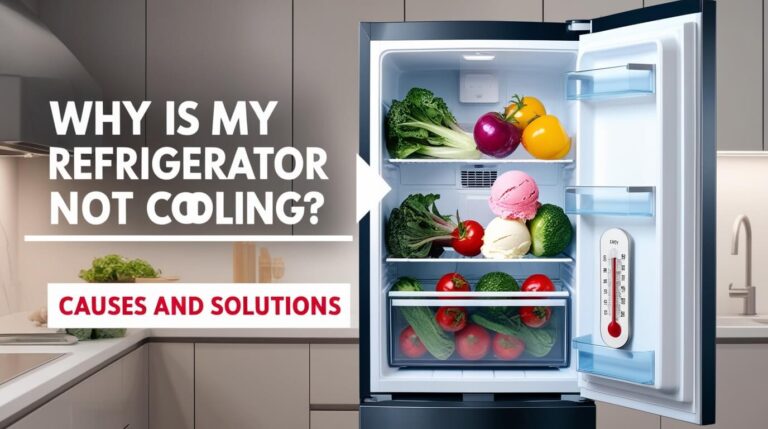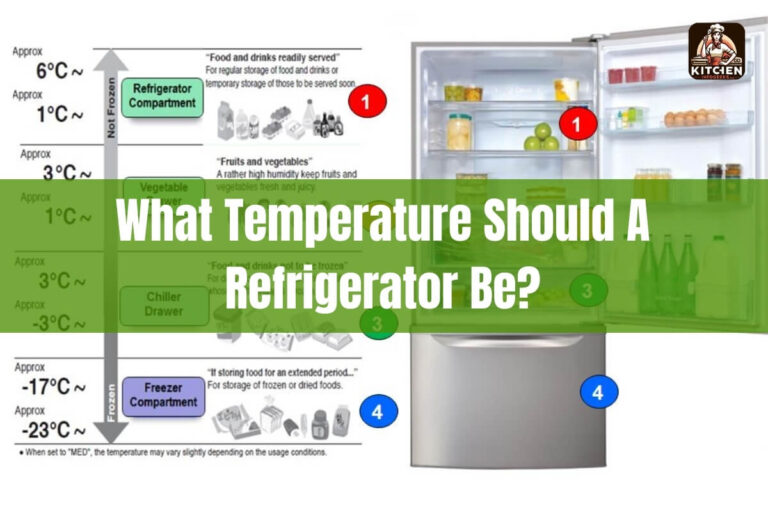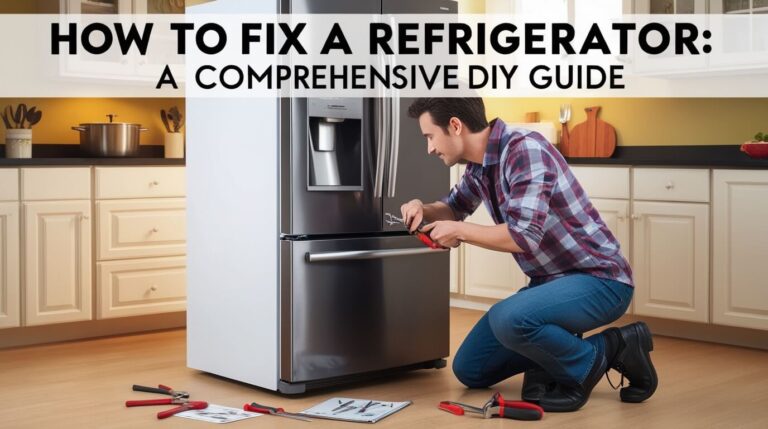
Refrigerator temperature fluctuations can be caused by various factors, including frequent door opening, faulty seals, or malfunctioning components. These fluctuations can impact food safety and energy efficiency.
Is your refrigerator playing hot and cold? You’re not alone. Many homeowners face this common appliance issue. Let’s figure out why your fridge is being so fickle.
Refrigerator Temperature Fluctuations
What’s considered normal temperature variation?
Your fridge isn’t a statue – it’s alive with cooling action! Small temperature shifts are normal and expected. Most refrigerators aim to keep food between 35°F and 38°F (1.7°C to 3.3°C). A variation of about 5°F (2.8°C) is usually nothing to worry about.
But when should you raise an eyebrow? If you notice frequent or extreme swings, it’s time to investigate. Food safety depends on consistent cooling, so keeping an eye on these fluctuations is crucial.
The importance of stable refrigerator temperatures
Steady temps aren’t just about keeping your drinks perfectly chilled. They’re vital for food safety and freshness. Bacteria love warmth, and they party hard when temperatures rise above 40°F (4.4°C). On the flip side, temps that dip too low can freeze your lettuce and ruin your milk.
Stable temperatures also help your fridge run efficiently. When your appliance doesn’t have to work overtime to correct temperature swings, it uses less energy. That’s a win for both your wallet and the environment!
Common Causes of Refrigerator Temperature Fluctuations
Frequent door opening and its impact
We’ve all been there – standing in front of the open fridge, pondering life’s great questions (like what to snack on). But did you know this habit can cause temperature fluctuations?
Every time you open the door, warm air rushes in. Your fridge then has to work harder to cool things down again. It’s like leaving your front door open on a hot day and expecting your AC to keep up!
Try to grab what you need quickly and limit unnecessary peeks. Your fridge (and your energy bill) will thank you.
Overfilling your refrigerator
More food means more cooling power, right? Not quite. Cramming your fridge full can actually hinder its cooling ability. Air needs to circulate to keep everything at the right temperature.
Imagine trying to cool a packed stadium versus a spacious room. Give your food some breathing room, and you’ll see more stable temperatures.
Faulty door seals and gaskets
Your fridge door’s seal is like a bouncer at a club – it keeps the cool in and the warm out. When this seal (also called a gasket) gets damaged or dirty, it can’t do its job properly.
Check your seal regularly. Look for cracks, tears, or buildup. A quick cleaning or replacement can make a world of difference in temperature stability.
Dirty condenser coils
Condenser coils are the unsung heroes of your fridge. They release heat from inside the appliance. When these coils get caked with dust and debris, they can’t do their job effectively.
Giving your coils a good vacuum every six months can help maintain stable temperatures and extend your fridge’s life. It’s like a spa day for your appliance!
Malfunctioning thermostats
Your fridge’s thermostat is its brain. It tells the cooling system when to kick in and when to take a break. If it’s not working right, your fridge might cool unevenly or not at all.
Signs of a faulty thermostat include rapid cycling of the compressor or temperatures that don’t match the setting. If you suspect thermostat trouble, it might be time to call in a pro.
Issues with the compressor or evaporator fan
The compressor is the heart of your cooling system, while the evaporator fan circulates the cold air. Problems with either can lead to temperature fluctuations.
Listen for unusual noises or feel for vibrations. If your fridge sounds like it’s trying to take off, there might be an issue with these components.
How to Diagnose Refrigerator Temperature Fluctuations
Using a reliable thermometer
Don’t trust the built-in temperature display alone. Invest in a good refrigerator thermometer. Place it in the center of the main compartment for the most accurate reading.
Check the temperature at different times of day. This will give you a clearer picture of how your fridge performs over time.
Monitoring temperature patterns
Keep a log of your fridge’s temperature for a few days. Note any patterns or extreme changes. Does it warm up at night? Cool down too much in the morning?
This information can be invaluable when troubleshooting or talking to a repair technician.
Checking for visible issues
Sometimes, the problem is right in front of you. Look for:
- Frost buildup in the freezer
- Water pooling under the crisper drawers
- Damaged door seals
- Blocked vents
A visual inspection can often reveal the culprit behind temperature swings.
Solutions to Stabilize Your Refrigerator’s Temperature
Proper food storage techniques
How you arrange your food can impact temperature stability. Here are some tips:
- Don’t block air vents with food items
- Use the right drawers for fruits and vegetables
- Keep raw meats on the bottom shelf
- Avoid storing hot leftovers immediately
Good organization not only helps with temperature but also keeps your food fresher for longer.
Regular maintenance tips
A little TLC goes a long way in preventing temperature fluctuations:
- Clean the interior regularly
- Vacuum the condenser coils twice a year
- Check and clean the door seals monthly
- Defrost manual-defrost freezers when ice buildup exceeds 1/4 inch
These simple tasks can keep your fridge running smoothly and efficiently.
Adjusting refrigerator settings
Sometimes, the solution is as simple as tweaking your fridge’s settings. Most refrigerators have a range of 1-7 or 1-5, with higher numbers being colder.
Start in the middle and adjust up or down based on your needs. Remember, changes can take 24 hours to fully take effect, so be patient!
When to call a professional
DIY is great, but some issues require expert hands. Call a pro if you notice:
- Persistent temperature problems despite your efforts
- Unusual noises or odors
- Water leaks
- A complete failure to cool
A certified technician can diagnose and fix complex issues safely and efficiently.
The Impact of External Factors on Refrigerator Temperature
Room temperature and placement
Your fridge doesn’t exist in a vacuum. The room temperature and where you place it can affect its performance.
Avoid putting your fridge near heat sources like ovens or sunny windows. Ensure there’s adequate ventilation around the appliance, especially at the back where the coils are.
Seasonal changes and humidity
As seasons change, so can your fridge’s performance. Higher humidity in summer can make the compressor work harder. In winter, a cold garage can trick the fridge into thinking it doesn’t need to cool as much.
Be prepared to adjust settings seasonally, especially for fridges in uncontrolled environments like garages or basements.
Advanced Technologies in Temperature Control
Smart refrigerators and temperature monitoring
Welcome to the future! Smart fridges can alert you to temperature fluctuations via your smartphone. Some even adjust themselves based on usage patterns.
While these features are cool (pun intended), remember that they’re not a substitute for good maintenance habits.
Dual cooling systems
High-end fridges often feature separate cooling systems for the fridge and freezer compartments. This can lead to more stable temperatures and better humidity control.
If you’re in the market for a new fridge, consider this feature for optimal temperature management.
When Temperature Fluctuations Indicate Serious Problems
Signs your refrigerator needs repair or replacement
Sometimes, temperature swings are a cry for help from your aging appliance. Watch out for:
- Excessive condensation inside the fridge
- Food spoiling faster than usual
- The motor running constantly
- Extreme temperature variations
If you notice these signs, especially in older models, it might be time for a repair or replacement.
Energy efficiency concerns
An inefficient fridge doesn’t just struggle with temperature – it guzzles electricity too. If your energy bills are climbing and your fridge is the culprit, consider upgrading to a more efficient model.
Look for Energy Star certified appliances. They use about 15% less energy than non-certified models, which can add up to significant savings over time.
Conclusion: Maintaining Stable Temperatures for Food Safety and Appliance Longevity
Keeping your refrigerator temperature steady isn’t just about having perfectly chilled drinks. It’s about food safety, energy efficiency, and making your appliance last longer.
Remember, small fluctuations are normal, but big swings need attention. Regular maintenance, smart storage habits, and prompt attention to issues can keep your fridge running smoothly for years to come.
By understanding the causes of temperature fluctuations and how to address them, you’re well on your way to becoming a fridge whisperer. Your food (and your wallet) will thank you for the effort!






